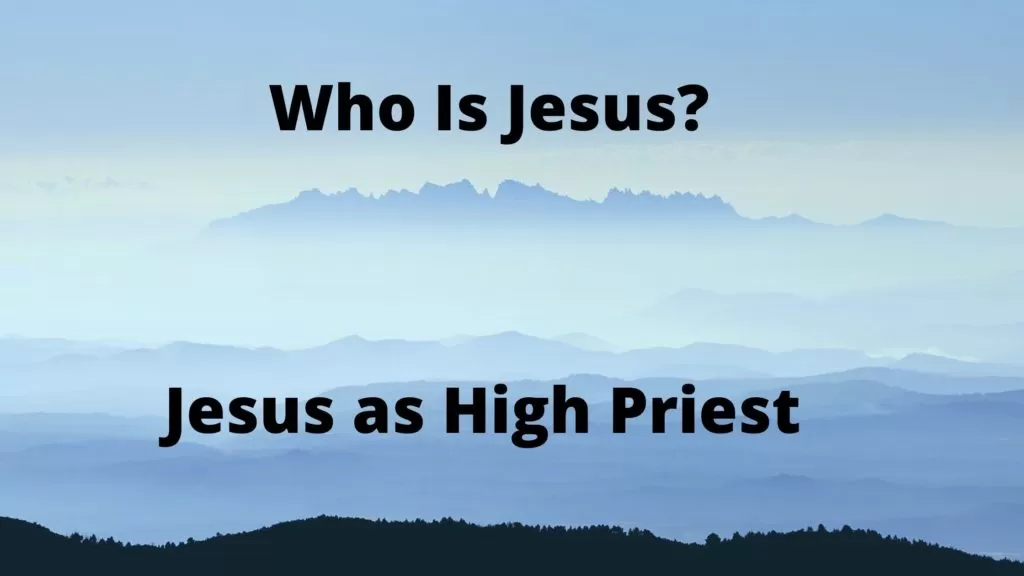In Part 2 of the “Who Is Jesus” series, we will be discussing Jesus as the high priest. To understand this, we have to look at a guy named Melchizedek and the original high priests. Guess where we find them? Yup, that’s right, they are in the Old Testament.
Melchizedek
Long before God had an established priesthood, there was a man named Melchizedek. Before his name was changed to Abraham, Abram was the only person in the Bible who met him. Abram had a nephew named Lot. Lot got himself in trouble, and Abram went to his rescue. On his way home, Abram meets Melchizedek. Genesis 14: 18-20 tells of the short exchange between the two:
“Then Melchizedek king of Salem brought out bread and wine. He was priest of God Most High, 19 and he blessed Abram, saying,
“Blessed be Abram by God Most High,
Creator of heaven and earth.
20 And praise be to God Most High,
who delivered your enemies into your hand.”
Then Abram gave him a tenth of everything.”
This was the entire exchange and yet it is an important one. This passage established Melchizedek as both a king and a priest.
Jesus and the Order of Melchizedek
The next place Melchizedek shows up is in Psalm 110, where David is prophesying about the coming of Jesus.
“The Lord has sworn
and will not change his mind:
“You are a priest forever,
in the order of Melchizedek.” (Ps 110:4 NIV)
After that, we don’t hear of this kingly priest until the writer of Hebrews shows the connection between Jesus and Melchizedek. Hebrews 7: 1-6 states:
This Melchizedek was king of Salem and priest of God Most High. He met Abraham returning from the defeat of the kings and blessed him, 2 and Abraham gave him a tenth of everything. First, the name Melchizedek means “king of righteousness”; then also, “king of Salem” means “king of peace.” 3 Without father or mother, without genealogy, without beginning of days or end of life, resembling the Son of God, he remains a priest forever.
4 Just think how great he was: Even the patriarch Abraham gave him a tenth of the plunder! 5 Now the law requires the descendants of Levi who become priests to collect a tenth from the people—that is, from their fellow Israelites—even though they also are descended from Abraham. 6 This man, however, did not trace his descent from Levi, yet he collected a tenth from Abraham and blessed him who had the promises.
Hebrews 7:11-12
If perfection could have been attained through the Levitical priesthood—and indeed the law given to the people established that priesthood—why was there still need for another priest to come, one in the order of Melchizedek, not in the order of Aaron? 12 For when the priesthood is changed, the law must be changed also.
A couple things to take note of in these passages. First, Melchizedek existed before the Levitical priesthood. There were no Levites and no priests yet. Melchizedek was a forerunner of what Jesus would be. He could not be a descendent of Levi because Levi didn’t exist yet. Because Melchizedek was both a king and a priest, Abram gave him a tenth of all he had.
Old Testament High Priest Garments
Israel consists of twelve tribes, with Levi being the tribe God chose to be priests. All priests were Levites, but not all Levites were priests. Those who were not priests served in various capacities such as doorkeepers, priestly assistants, and musicians, just to name a few. There was only one High Priest, with Aaron being the first. He was commissioned by his brother Moses.
Exodus 28 gave instruction as to what the priestly garments were. Ordinary priests wore four garments: pants (underwear), tunic, hat (turban), and belt. The High Priest wore eight pieces of clothing. The same four as the ordinary priests along with four more: a robe, ephod, breastplate, and crown. The ephod was an apron that was put on over the robe. The breastplate was worn over the ephod and carried twelve stones that represented each of the twelve tribes. The crown was a gold band that went around the base of the turban. Priestly clothes were not sewn as ordinary clothes were, but rather, they were woven.
The Crucifixion
Fast forward 1400 years to the crucifixion. In the last blog, I explained that the High Priest and Jesus simultaneously declared, “It is finished.” The High Priest finished killing the final sacrificial lamb at the same time Jesus died. This made him both the sacrificial lamb and High Priest – but I digress, onto Psalm 22!
In Psalm 22:18, King David prophesied that lots would be cast for Jesus’ clothes. John 19:23 gives the account of that day:
“When the soldiers crucified Jesus, they took his clothes, dividing them into four shares, one for each of them, with the undergarment remaining. This garment was seamless, woven in one piece from top to bottom.”
Did you catch that? Jesus’ undergarment was seamless and woven in one piece – just as the priestly undergarments were.
High Priests on the Day of Atonement
The Day of Atonement, aka Yom Kippur, is the holiest in Judaism. On this day, the High Priest entered the temple and went to the area called The Holy of Holies. The Holy of Holies was an inner room that sat behind a thirty-foot curtain in the temple in Jerusalem. This was where the Ark of the Covenant was housed. On the top of the Ark sat two gold cherubim. God dwelt on the top of the Ark between the cherubim in an area called the Mercy Seat. The Holy of Holies was only accessible once a year on the Day of Atonement and only to the High Priest. He entered four times wearing four pieces of white linen; the pants (underwear), tunic, belt, and turban, and approached God personally. This was the day the High Priest made atonement for the sins of Israel. It was the only day he didn’t wear all eight pieces of his priestly garments.
The Crucifixion and the Tearing of the Curtain
After Jesus said, “It is finished,” he died. Matthew 27:50-51 gives the account:
50 And when Jesus had cried out again in a loud voice, he gave up his spirit.
51 At that moment the curtain of the temple was torn in two from top to bottom.
The curtain that tore in the temple was the curtain that hid the Holy of Holies. The death of Jesus as High Priest ripped the curtain and made the Holy of Holies accessible to all. No longer would only one man be allowed access to God personally, but through Jesus, we all have access. This created the shift from the Old Testament high priests to Jesus as High Priest. It ended animal sacrifices and opened the way for the Gentiles (non-Jews) to know God. Then, in 70AD, the Romans destroyed the temple, which ended that form of worship.
Old Testament High Priest Government
The High Priest was a national leader and a religious leader. By God’s design, the Israelites were once without an earthly king. They were ruled by judges who answered to God. Eventually, the people demanded a king like other nations (1Sam 8). Deut 17:18-19 tells us that the kings of Israel were to have the Levitical laws written for them. They were expected to read them daily and govern accordingly. The priests were a merging of religious rule and civil rule.
Jesus as Religious and Civil Ruler
Isaiah delivers a prophetic word concerning the Messiah (Jesus) (Is 9:6-7):
For to us a child is born,
to us a son is given,
and the government will be on his shoulders.
And he will be called
Wonderful Counselor, Mighty God,
Everlasting Father, Prince of Peace.
7 Of the greatness of his government and peace
there will be no end.
He will reign on David’s throne
and over his kingdom,
establishing and upholding it
with justice and righteousness
from that time on and forever.
The zeal of the Lord Almighty
will accomplish this.
Jesus will have the government on his shoulder, the greatness of his government will have no end, and he will rule on the throne of David with justice and righteousness. David was also a king and a bit of a priest. He built a tabernacle and directed worship. Much like Melchizedek, who was not a Levite, neither was David. David came from the tribe of Judah, as did Jesus. So while Israel no longer has kings, the throne that Isaiah is talking about is a spiritual lineage at this point in time. But hold on! The explanation is below.
When Jesus came the first time, he came to establish a new form of worship. Instead of the temple with animal sacrifices and Levitical priests, we now have a new foundation of apostles, prophets, evangelists, teachers, and pastors (Eph 4:11). These five roles are now the foundation of the church. This was how the early church governed itself. In the New Testament, the word “church” is the Greek word ecclesia. The ecclesia was a political assembly in Greece. When Jesus used the word ecclesia, everyone understood it was a governing body and not necessarily what we think of as church in the modern Western world. It was radically different from life in the temple. This is the government Jesus came to change during his first time on earth.
The Government of the Second Coming
While Jesus was on earth, he established a new structure of worship, but many were looking for a messiah that would rule on an earthly throne – and rightly so! Many Old Testament prophecies state this. Although this didn’t happen as the people hoped for, it will happen. At the second coming, Jesus will be seated as king. He will rule over the earth, not just Israel, and he will rule as a priest and a king (too many scripture references to note!).
Jesus the Great High Priest
Hebrews 4:14 – 5:10 is titled, “Jesus the Great High Priest.” This is a long passage, so I am leaving you with only a portion of it. I encourage you to read it for yourself! Hebrews 4:14-16:
14 Therefore, since we have a great high priest who has ascended into heaven, Jesus the Son of God, let us hold firmly to the faith we profess. 15 For we do not have a high priest who is unable to empathize with our weaknesses, but we have one who has been tempted in every way, just as we are—yet he did not sin. 16 Let us then approach God’s throne of grace with confidence, so that we may receive mercy and find grace to help us in our time of need.
Have confidence and approach the throne where mercy and grace await you!



